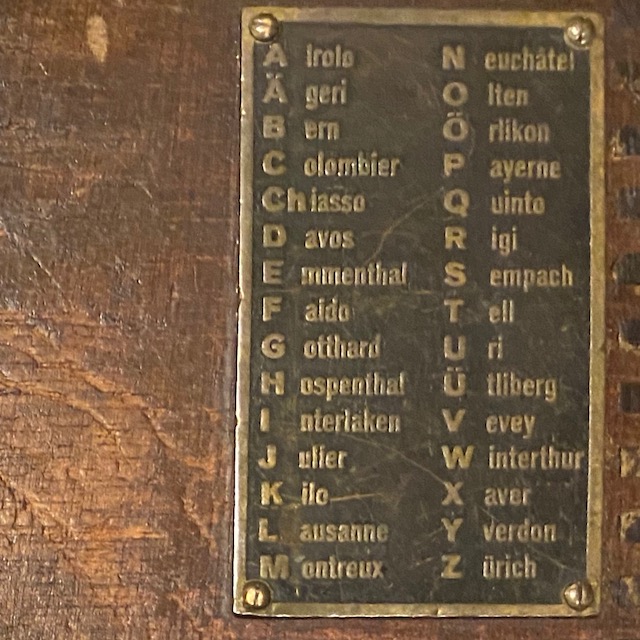
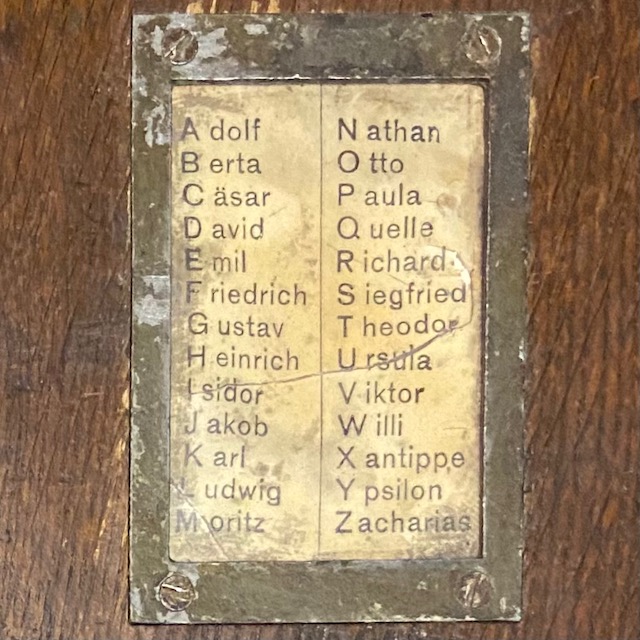

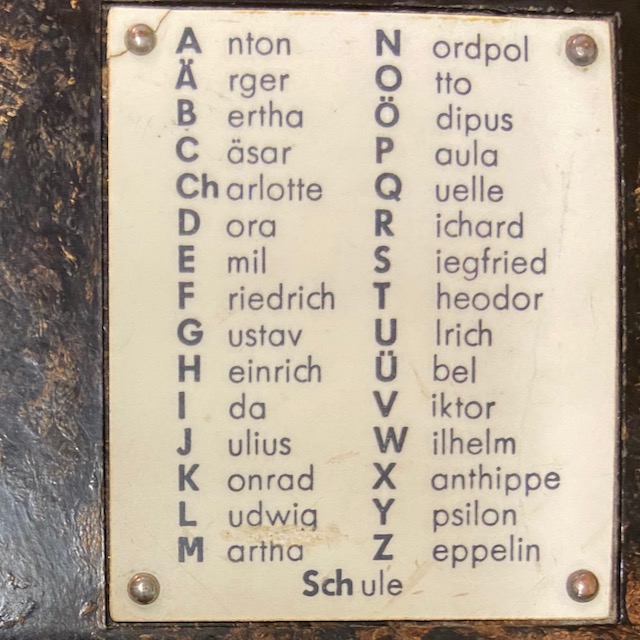

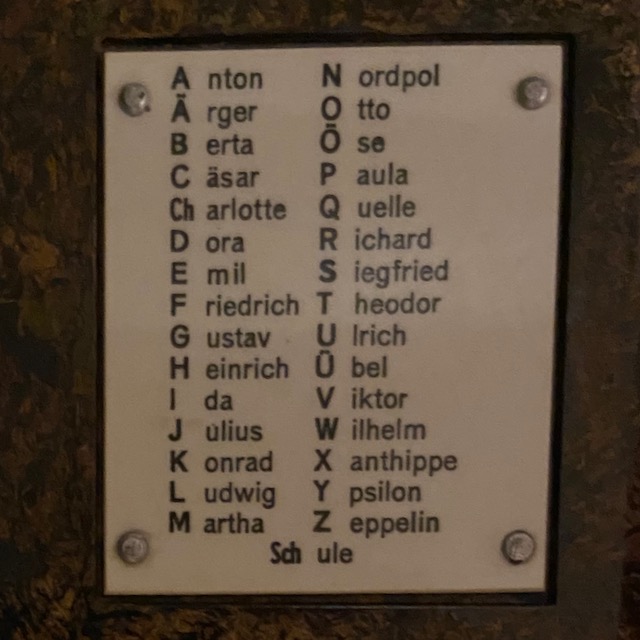

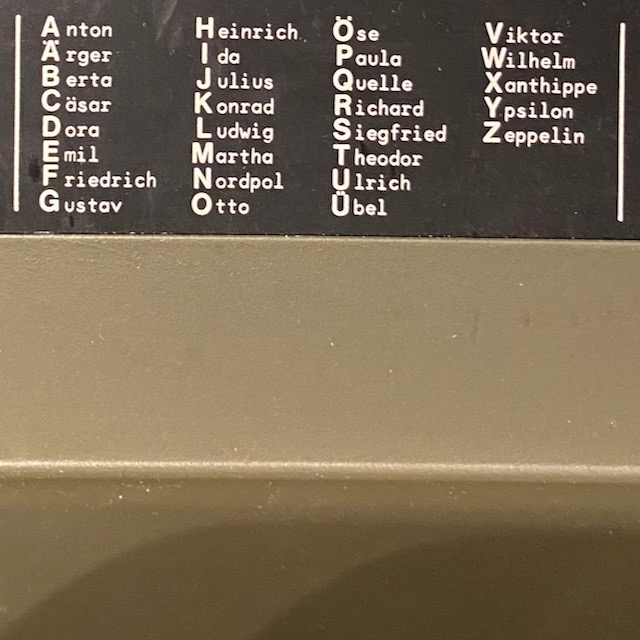
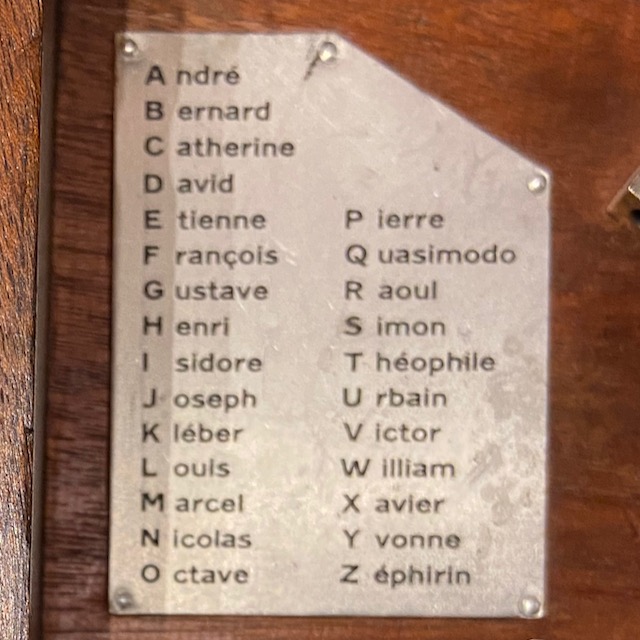
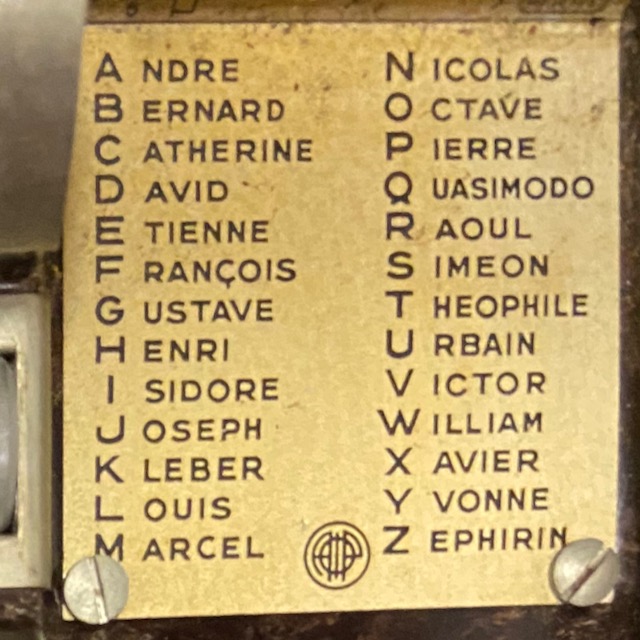
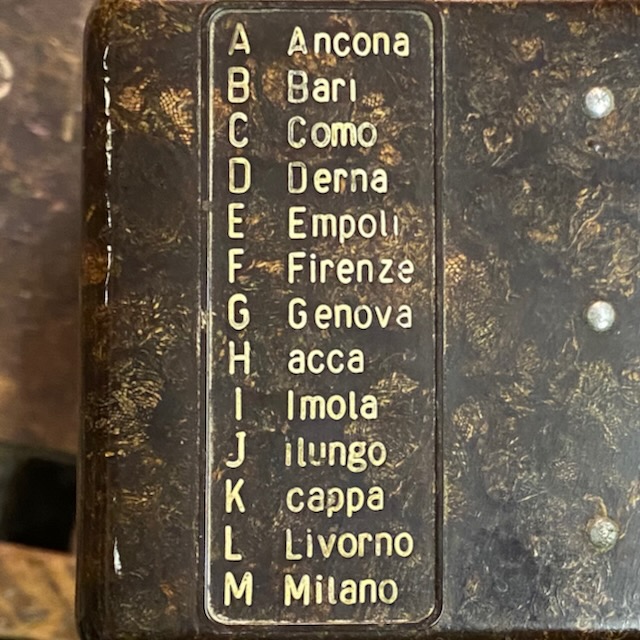
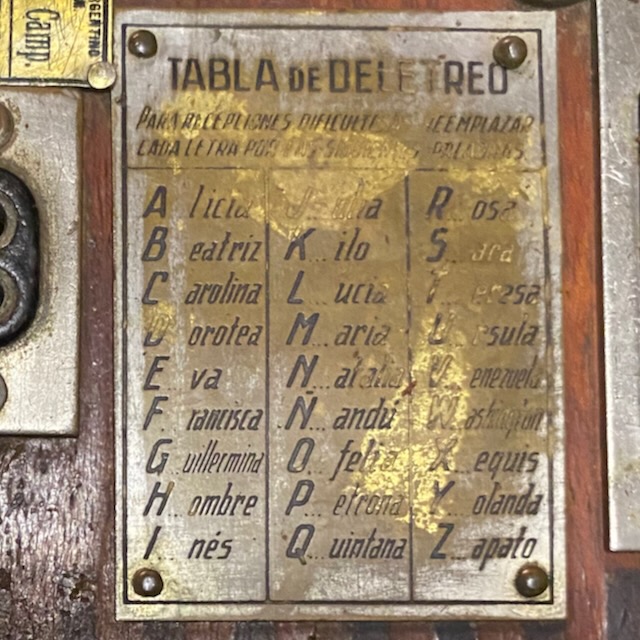

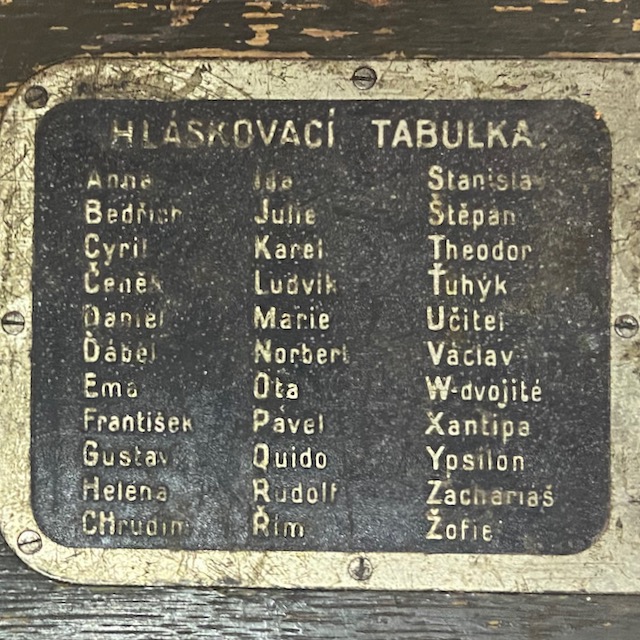
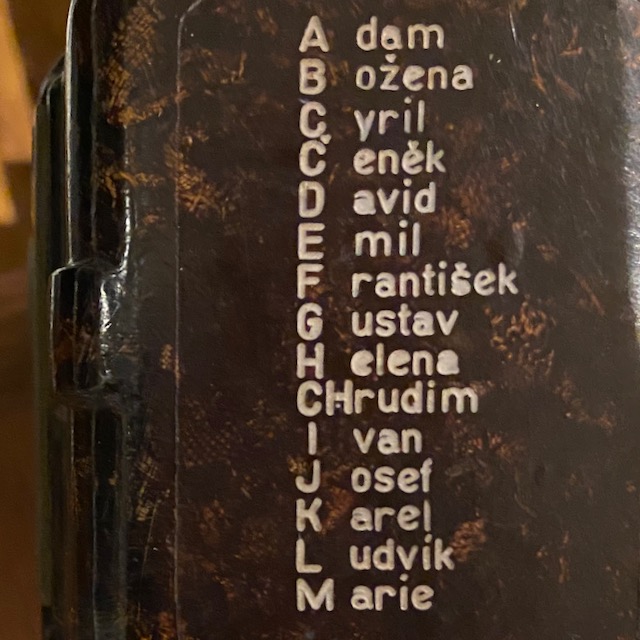


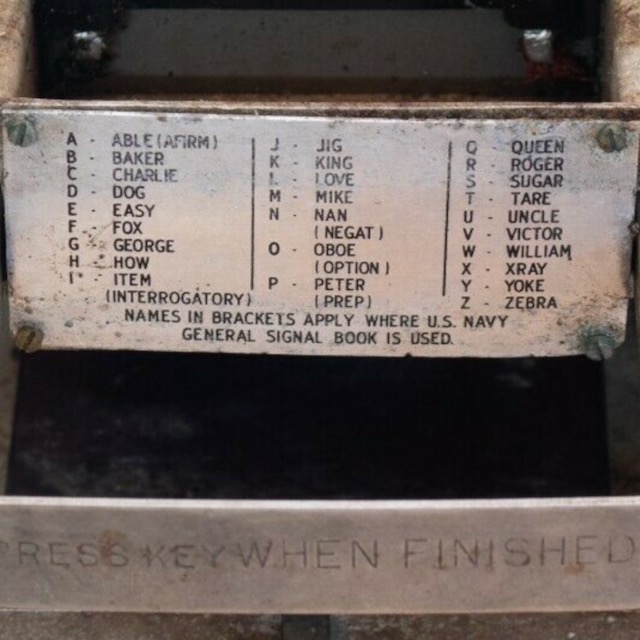
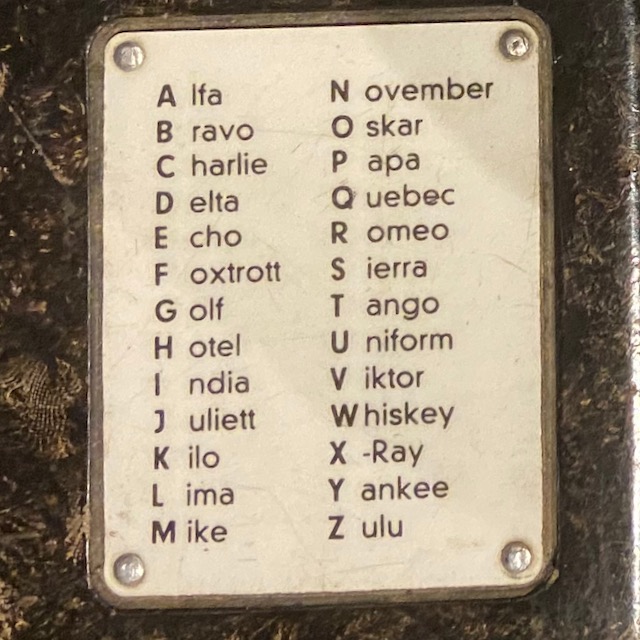
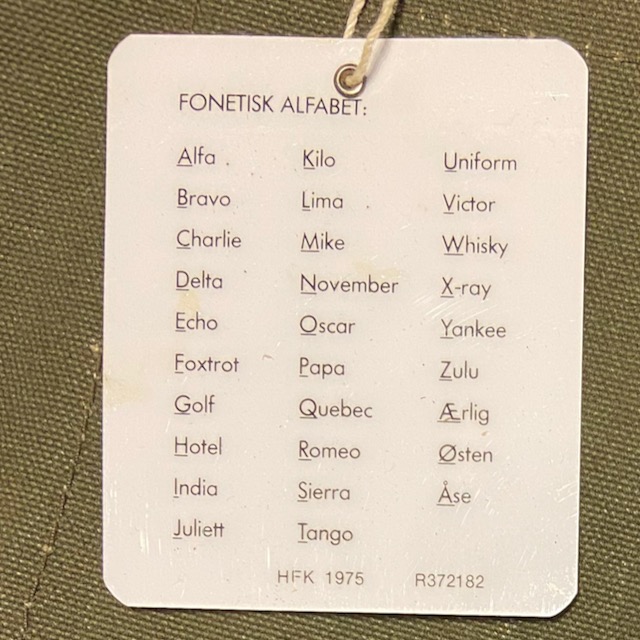

Zerlegbares T.
FF 33<1939
BRD FF 54
Modell 1932
FF 63
TM 32
1933
1954
1963
1932
To improve accuracy of reception on noisy connections spelling alphabets were used in civil and military communications. First spelling alphabets were first published in telephone books of the late 19th century.
Already to be found on WW1 era military field instruments e.g. from Germany and Britain. Continued to be added to instruments until the end of the field-phone era. Up to now I've never seen spelling alphabets on US instruments, but on a lot of instruments from all over Europe.
Below the comparison table you find details regarding each alphabet. Where not otherwise noted the pictures are from devices in my collection.
| Examples |  |
 |
 |
 |
 |
 |
 |
 |
 |
 |
 |
 |
 |
 |
 |
 |
 |
 |
 |
 |
 |
|||||
|---|---|---|---|---|---|---|---|---|---|---|---|---|---|---|---|---|---|---|---|---|---|---|---|---|---|---|
| Language | German | German | German | German | German | German | German | German | German | French | French | Italian | Spanish | Hungarian | Czech | Czech | Serbo-croatian | Swedish | Finnish | Turkish | Greek (Latin sorting) | English | English | Nato | Nato | Nato |
| Country | Switzerland | Switzerland | Germany | Germany | Germany | Germany | Germany (DDR) | Austria | Austria | France | France | Italy | Argentina | Hungary | Czechoslovakia | Czechoslovakia | Yugoslavia | Sweden | Finnland Estland | Turkey | Greece | UK (1938) | UK (1943) | Germany | Norway | Denmark |
| Instruments | Art Tf Zerlegbares T. |
none | FF16 | FF 26 FF 33<1939 |
FF 33 >1939 BRD FF 54 |
Norwegian EB Modell 1932 |
FF 53 FF 63 |
M35 | F-27-0 | Modell 27 TM 32 |
AT2 | Modell 42 | TTA 5 | 41 M / TBK-1 | vz 35 | TP 25 | M-63 | M/37 | P-1-8 | EB 32 | Telephonwerke Albisrieden | F.Mk.I. | D.Mk.V. | FF 54 | TP-6N-A | M/51 |
| Years | 1915 | >1950 | 1916 | 1926 1933 |
1939 1954 |
1941 | 1953 1963 |
1935 | 1980 | 1927 1932 |
1950 | 1942 | 1941 | 1941 | 1935 | 1950 | 1963 | 1937 | 1938 | 1935 | 1930 | 1938 | 1943 | 1954 | 1975 | 1951 |
| A | Airolo | Anna | Adolf | Anton | Anton | Anton | Anton | Adolf | Anton | André | André | Ancona | Alicia | Andras / Agnes | Adam | Adam | Avala | Adam | Aarne | Ahmet / Ali | ΑΝΤΩΝΙΟΣ (Antonios) | AC | Able (Afirm) | Alfa | Alfa | Alfa |
| B | Bern | Berta | Berta | Bruno | Bertha | Bertha | Berta | Berta | Berta | Bernard | Bernard | Bari | Beatriz | Borbala | Bedrich | Bozena | Beograd | Bertil | Bertta | Behcet | ΒΑΣΙΛΕΙΟΣ (Vasileios) | Beer | Baker | Bravo | Bravo | Bravo |
| C | Colombier | Carlo | Cäsar | Cäsar | Cäsar | Cäsar | Cäsar | Cäsar | Cäsar | Catherine | Catherine | Como | Carolina | Cegled / Csongrad | Cyril / Cenek | Cyril / Cenek | Cetinje | Cesar | Celsius | Cavit / Celebi | ΧΑΡΙΛΑΟΣ (Charilaos) | Charlie | Charlie | Charlie | Charlie | Charlie |
| D | Davos | Daniel | David | Dora | Dora | Dora | Dora | David | Dora | David | David | Derna | Dorotea | Denes | Daniel / Dabel | David | Drvar | David | Daavid | Davut | ΔΗΜΗΤΡΙΟΣ (Dimitrios) | Don | Dog | Delta | Delta | Delta |
| E | Emmenthal | Emil | Emil | Emil | Emil | Emil | Emil | Emil | Emil | Etienne | Etienne | Empoli | Eva | Erzsebet / Eva | Ema | Emil | Europa | Erik | Eemeli | Ekrem | ΕΛΛΑΣ (Ellas, Greece) | Edward | Easy | Echo | Echo | Echo |
| F | Faido | Figaro | Friedrich | Fritz | Friedrich | Friedrich | Friedrich | Friedrich | Friedrich | Francois | Francois | Firenze | Francisca | Ferenc | Frantisek | Frantisek | Foca | Filip | Faarao | Fehmi | ΦΩΤΙΟΣ (Fotios, fire) | Freddie | Fox | Foxtrott | Foxtrot | Foxtrot |
| G | Gotthard | Gustav | Gustav | Gustav | Gustav | Gustav | Gustav | Gustav | Gustav | Gustave | Gustave | Genova | Guillermina | Gabor | Gustav | Gustav | Gorica | Gustaf | Gideon | Galip | ΓΕΩΡΓΙΟΣ (Georgios) | George | George | Golf | Golf | Golf |
| H | Hospenthal | Hippolyt | Heinrich | Heinz | Heinrich | Heinrich | Heinrich | Heinrich | Heinrich | Henri | Henri | Acca | Hombre | Hungaria | Helena | Helena | Heroj | Harald | Heikki | Hasan | ΗΛΙΟΣ (Ilios, sun) | Harry | How | Hotel | Hotel | Hotel |
| I | Interlaken | Ida | Isidor | Ida | Ida | Ida | Ida | Isidor | Ida | Isidore | Isidore | Imola | Ines | Istvan | Ida | Ivan | Istra | Ivar | Iivari | Ishak / Irak | ΙΩΑΝΝΗΣ (Ioannis) | Ink | Item (Interrogatory) | India | India | India |
| J | Julier | Jakob | Jakob | Jot | Julius | Julius | Julius | Jakob | Julius | Joseph | Joseph | Ilungo | Julia | Janos | Julie | Josef | Jadran | Johan | Jussi | Jale | - | Johnnie | Jig | Juliett | Juliett | Juliett |
| K | Kilo | Kilo | Karl | Kurfürst | Konrad | Konrad | Konrad | Karl | Konrad | Kléber | Kléber | Cappa | Kilo | Kalman | Karel | Karel | Kosovo | Kalle | Kalle | Kadri | ΚΩΝΣΤΑΝΤΙΝΟΣ (Konstantinos) | King | King | Kilo | Kilo | Kilo |
| L | Lausanne | Leopold | Ludwig | Ludwig | Ludwig | Ludwig | Ludwig | Ludwig | Ludwig | Louis | Louis | Livorno | Lucia | Löring | Ludvik | Ludvik | Lika | Ludvig | Lauri | Lutfi | ΛΑΜΠΡΟΣ (Lampros) | London | Love | Lima | Lima | Lima |
| M | Montreux | Maria | Moritz | Marie | Martha | Martha | Martha | Moritz | Martha | Marcel | Marcel | Milano | Maria | Mihaly | Marie | Marie | Mostar | Martin | Matti | Mehmet | MIΧΑΕΛ (Michael) | Monkey | Mike | Mike | Mike | Mike |
| N | Neuchatel | Nicola | Nathan | Nordpol | Nordpol | Nordpol | Nordpol | Nathan | Nordpol | Nicolas | Nicolas | Napoli | Natalia | Nandor | Norbert | Neruda | Nis | Niklas | Niilo | Nizami | ΝΙΚΟΛΑΟΣ (Nicolaos) | Nuts | Nan (Negat) | November | November | November |
| O | Olten | Olga | Otto | Otto | Otto | Otto | Otto | Otto | Otto | Octave | Octave | Otranto | Ofelia | Olga / O-buda | Ota | Otakar | Osijek | Olof | Otto | Osman | ΟΡΕΣΤΗΣ (Orestis) | Orange | Oboe (Option) | Oskar | Oscar | Oscar |
| P | Payerne | Pietro | Paula | Paula | Paula | Paula | Paula | Paula | Paula | Pierre | Pierre | Palermo | Petrona | Piroska | Pavel | Petr | Pirot | Petter | Paavo | Pasa | ΠΑΝΑΓΙΩΤΗΣ (Panagiotis) | Pip | Peter (Prep) | Papa | Papa | Papa |
| Q | Quinto | Quasi | Quelle | Quelle | Quelle | Quelle | Quelle | Quelle | Quelle | Quasimodo | Quasimodo | Quarto | Quintana | - | Quido | Quido | Kvorum | Qvintus | Kuu | - | ΘΕΟΔΩΡΟΣ (Teodoros) | Queen | Queen | Quebec | Quebec | Quebec |
| R | Rigi | Rosa | Richard | Richard | Richard | Richard | Richard | Richard | Richard | Raoul | Raoul | Roma | Rosa | Rozal | Rudolf / Rim | Rudolf / Rehor | Ruma | Rudolf | Risto | Rasim | ΡΟΔΟΣ (Rodos) | Robert | Roger | Romeo | Romeo | Romeo |
| S | Sempach | Sophie | Siegfried | Siegfried | Siegfried | Siegfried | Siegfried | Siegfried | Siegfried | Simon | Simeon | Savona | Sara | Sari / Szabadka | Stanislav / Stepan | Svatopluk / Sarka | Skopje | Sigurd | Sakari | Sait / Saban | ΣΤΕΦΑΝΟΣ (Stefanos) | Sugar | Sugar | Sierra | Sierra | Sierra |
| T | Tell | Theodor | Theodor | Toni | Theodor | Theodor | Theodor | Theodor | Theodor | Théophile | Théophile | Torino | Teresa | Tamas | Theodor / Tuhyk | Tomas | Tetovo | Tore | Tyyne | Tevfik | ΤΗΛΕΜΑΧΟΣ (Tilemachos) | Toc | Tare | Tango | Tango | Tango |
| U | Uri | Ulrich | Ursula | Ulrich | Ulrich | Ulrich | Ulrich | Ursula | Ulrich | Urbain | Urbain | Udine | Ursula | Ungvar | Ucitel | Urban | Uzice | Urban | Urho | Uguz | ΨΑΡΡΑ (Psarra, fish) | Uncle | Uncle | Uniform | Uniform | Uniform |
| V | Vevey | Viktor | Viktor | Viktor | Viktor | Viktor | Viktor | Viktor | Viktor | Victor | Victor | Venezia | Venezuela | Veronika | Vaclav | Vaclav | Valjevo | Viktor | Vihtori | Vehbi | - | Vic | Victor | Victor | Victor | Victor |
| W | Winterthur | Willy | Willi | Wilhelm | Wilhelm | Wilhelm | Wilhelm | Willy | Wilhelm | William | William | Vidoppio | Washington | - | W-Dvojite | Dvojite V | Duplo Ve | Wilhelm | kaksink.V | - | ΩΡΟΛΟΓΙΟΝ (Orologion, clock,watch) | William | William | Whiskey | Whisky | Whiskey |
| X | Xaver | Xaver | Xanthippe | Xanthippe | Xanthippe | Xanthippe | Xanthippe | Xanthippe | Xanthippe | Xavier | Xavier | Ics | Equis | - | Xantipa | Xaver | Iks | Xerxes | Äksa | - | ΞΑΝΘΗ (Xanthi, blond) | X-ray | Xray | X-ray | X-ray | Xray |
| Y | Yverdon | Yvonne | Ypsilon | Ypern | Ypsilon | Ypsilon | Ypsilon | Ypsilon | Ypsilon | Yvonne | Yvonne | Igreco | Yolanda | Ypsilon | Ypsilon | Ypsilon | Ipsilon | Yngve | Yrjö | Yahaya | ΥΨΗΛΑΝΤΗΣ (Ypsilantis, highlander) | Yorker | Yoke | Yankee | Yankee | Yankee |
| Z | Zürich | Zenith | Zacharias | Zeppelin | Zeppelin | Zeppelin | Zeppelin | Zacharias | Zeppelin | Zéphirin | Zéphirin | Zara | Zapato | Zoltan / Zsofia | Zacharias / Zofie | Zuzana / Zofie | Zagreb | Zäta | Tseta | Zühtü | ΖΑΚΥΝΘΟΣ (Zakynthos) | Zebra | Zebra | Zulu | Zulu | Zulu |
| Å | - | - | - | - | - | - | - | - | - | - | - | - | - | - | - | - | - | Åke | ruotsal. O | - | - | - | - | - | Åse | Åse |
| Ä | Ägeri | Anna-Emil | - | Ärger | Ärger | Ärger | Ärger | - | Ärger | - | - | - | - | - | - | - | - | Ärlig | Äiti | - | - | - | - | Ærlig | Ægir | |
| Ö | Örlikon | Olga-Emil | - | Öse | Ödipus | Ösel | Öse | - | Öse | - | - | - | - | Ödön | - | - | - | Östen | Öljy | Ömer | - | - | - | - | Osten | Odis |
| Ü | Ütliberg | Ulrich-Emil | - | Übel | Übel | Übel | Übel | - | Übel | - | - | - | - | Üteg | - | - | - | Übel | saksal. Y | Ümit | - | - | - | - | - | - |
| CH | Chiasso | - | - | Charlotte | Charlotte | Charlotte | Charlotte | - | - | - | - | - | - | - | Chrudim | Chrudim | - | - | - | - | - | - | - | - | - | |
| SCH | - | - | - | - | Schule | Schule | Schule | - | - | - | - | - | - | - | - | - | - | - | - | - | - | - | - | - | - | - |
| Ñ | - | - | - | - | - | - | - | - | - | Ñandu |
A Swiss specific german spelling alphabet was added to Swiss field instruments up to the Armeetelefon 47. The Feldtelefon 50 had none added anymore. On the instruments which were still in use in the 50ies the old alphabets were removed as a new Swiss spelling alphabet, based mostly on first names, was introduced. This new alphabet was never added to the instruments. Nowadays the Swiss army uses the international (Nato) spelling table. If there were different spelling alphabets for french or italian speaking troops I'm still trying to find out.
On older instruments, like the example below, the old spelling alphabet can still be found. That alphabet used mainly Swiss location names (Cities, Mountains, Regions) with the exceptions of K(ilo), T(ell) and X(aver). The alphabet also includes the Umlauts and the Ch.
Armeetelefon Modell 1932 (On most Modell 32 and 47 the alphabet has been removed, instruments where it is still present are quite rare)

The newer alphabet was introduced somewhere in the early fifties (An army telephony regulation of 1951 still mentions the alphabets mounted on the instruments, whereas an army radio regulation of 1955 prints the new version). The new alphabet is based around first names, it keeps only K(ilo) and X(aver) from the older alphabet. Non first names are the already mentioned K(ilo) and then also Q(uasi) and Z(enith). For the Umlauts respective combinations with E(mil) are used like e.g. for Ö: O(lga)-E(mil).
The example below is out of the Swiss army regulation 58.17d - Taschenbuch des Telegraphen Pioniers from 1967.
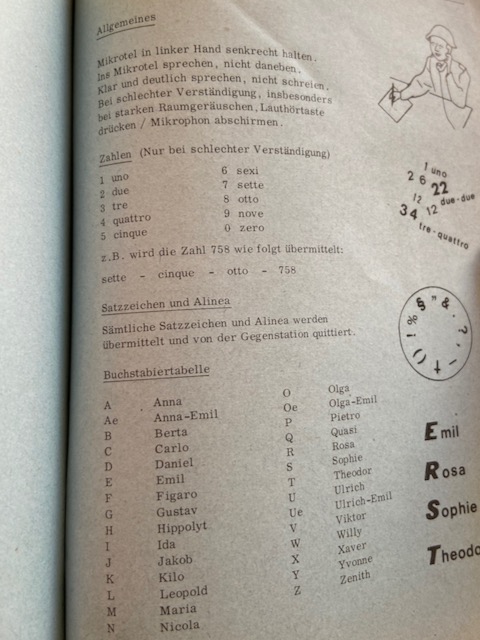
The german spelling alphabet has changed a few times between the two wars because of nazification. The pre-Nazi alphabet used A(dolf) which I assume that had to be replaced because is was not well suited to use the crazy big bosses name for such lowly use as spelling. D(avid), J(akob), N(athan) and Z(acharias) were dropped based on their jewish heritage, and Moritz probably because of the African heritage of St. Maurice. During that time also the civil table printed in telephone books was nazified, but after the war then also un-nazified again reinstating at least S(amuel), which was never used in the military version, and Z(acharias). Why I(sidor) and K(arl) had to go is less clear, K(arl) probably because of confusion with C(arl), if K(onrad) was a better solution though? The early Nazi spelling alphabet had also shortened F(riedrich) and H(einrich) to F(ritz) and H(einz), but changed W(illy) to W(ilhelm). The later version from around 1939 used F(riedrich) and H(einrich) again. Also Sch(ule) was added to that version. Another strange change is Y(pern), which was Y(psilon) and then became Y(psilon) again. Apparently they wanted to commemorate the abominable things they did to Ypern in WW1, like the first uses of poison gases. X(anthippe) survived all versions and she got Ö(dipus) as companion, before Ö(dipus) Ö(se), meaning lug, was used.
The nazified version from 1939 was continued to be used in Germany and Austria after WW2, in east Germany slightly adapted going back from B(ertha) to B(erta) and Ö(dipus) to Ö(se). The Bundeswehr started later to use the NATO version.
Feldfernsprecher 16, with the german pre-Nazi version. No Umlauts.

Feldfernsprecher 26, with the early nazified version (This FF26 was made in 1935).

Feldfernsprecher 33, with the early nazified version found on FF33 up to ~1939.
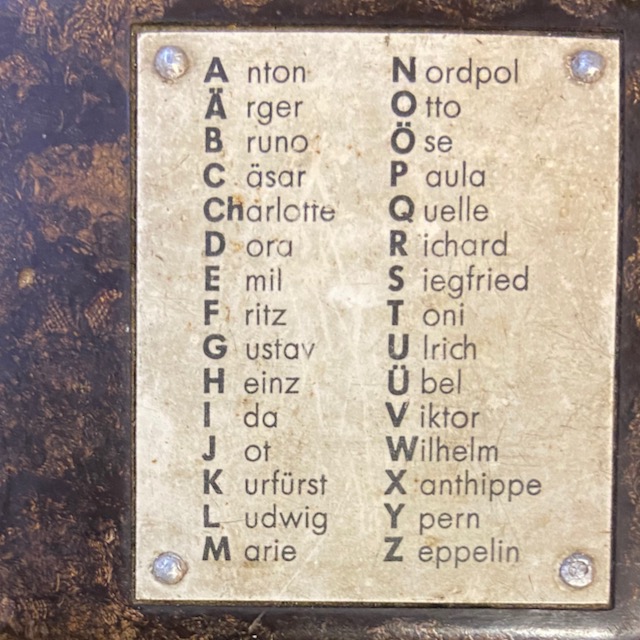
Feldfernsprecher 33, with the later nazified version found on FF33 after 1939.

Norwegian Elektrisk Bureau Modell 1932 (Similar build than the Austrian M35), with the later nazified version with the exception of Ö(sel). Probably an instrument adapted after the occupation of Norway by someone who didn't got the Ödipus memo.

Feldfernsprecher OB/ZB (1954), this one used by the german Post, still with the nazified version.
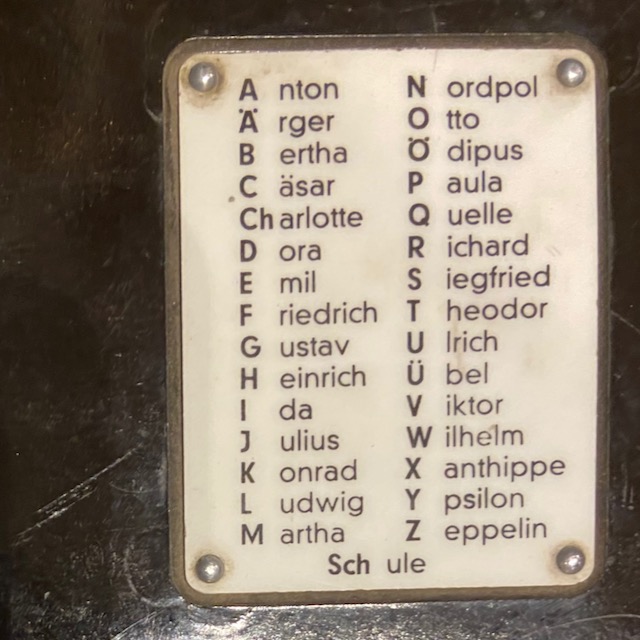
East german Feldfernsprecher 53 and 63 with a slight adaption of the nazified version, B(erta) instead of B(ertha) and Ö(se) instead of Ö(dipus).


Austria used always more or less unaltered german versions. On old instruments the original WW1 version and on new instruments up to at least the 80ies the nazified version.
Kapsch M35, with the german pre-Nazi version. No Umlauts.

Siemens SFT800 / F-27-0, B(erta) instead of B(ertha) and Ö(se) instead of Ö(dipus).

The french are the only who managed to stick to the first name concept without exceptions. No relevant differences over the years. On the latest I own (1950) S(imon) changed to S(imeon).
Modele 1927, Telephone Militaire 32, Telephone AT2 (1950).



This Italian spelling alphabet uses mostly place names with the exception of some in Italian not often used letters where these letters names are used: H (hacca), J (ilungo), K (cappa), W (vidoppio), Y (igreco) and X (ics).
Telefono Campale Mod. 42, the alphabet is distributed between the left and right edges of the bakelite lid.


The argentine spanish spelling alphabet uses female first names with a few exceptions: H(ombre), Ñ(andu), V(enezuela), W(ashington), X (equis) and Z(apato).
Argentine Field Telephone TTA 5 (1941).

The Hungarian alphabet is an extended latin alphabet, some letters are a base letter marked by an acute or umlaut indicator, like O, Ó and Ö. Others are indicated by combining two letters, like S and Sz. In above comparison table I simplified this by placing the different options mostly on the same line than the base letter. Interesting is also that Hungarian does not use the letters Q, W and X. Most letters are represented by first names with a few exceptions like H(ungaria) and Y(psilon).
Hungarian field-phone 41 M / TBK-1.

The czech alphabet has also a few additional letters which I added to the same line as the base letter in above comparison table. Most letters are again represented by first names. An interesting exception is W which is spelled as Dvojite V (double-u) and CH(rudim) which is a city. The pre and post WWII versions differ for many letters, Norbert has been replaced with Neruda probably to honor Jan or/and Pablo Neruda.
Czech field-phone vz. 35 (1935).

Czech field-phone TP 25 (1950), the alphabet is distributed between the left and right edges of the bakelite lid.


The Yugoslavian (Serbo-croatian) alphabet uses mostly place names. Interesting are the letters Q - Kvorum, X - Iks and Y - Ipsilon represented by words that do not use the letter they represent. Some additional letters added after Z(agreb) I ignored in above comparison table.
Yugoslavian field-phone M63. A number spelling table is also present.

The Swedish alphabet uses again mostly first names but for the Umlauts and Z(äta) which is the letter itself in Swedish.
Swedish field-phone M/37 (One of the longest serving models, developed in the early 30ies and manufactured up to the 70ies and in service up to the 21st century). The model in the picture was made in 1966. A number spelling table is also present.
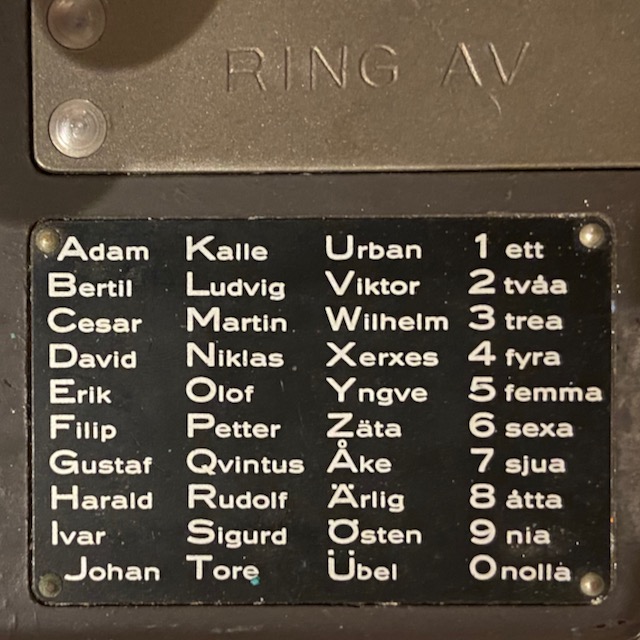
The Finnish alphabet uses also mostly first names or for some cases e.g. Q - Kuu or Z - Tseta the name of the letter itself.
Finnish field-phone P-1-8, this model was made for the Finnish army by Tartu Telefoni Vabrik in Estland in the late 30ies. A number spelling table is also present. The alphabet on my instrument is a self-made reproduction.

The Turkish alphabet uses also mostly first names and has no letter Q.
Turkish field-phone made by Elektrisk Bureau Norway, corresponding to the EB Model 1932 (Not from my collection).

The Greek alphabet uses a lot of first names, geographical names (Greece, Rodos) and also miscellaneous like Sun (ΗΛΙΟΣ) and Watch (ΩΡΟΛΟΓΙΟΝ).
Greek field-phone made by Telephonwerke Albisrieden (Swiss Siemens), from the 1930ies.

The us and uk armies started to use spelling alphabets already prior to WW1. But until WW2 often different army branches used their own versions. A good overview of british phonetic alphabets here at royalsignals.org.uk. During WW2 us and commonwealth troops agreed on a Allied spelling alphabet defined by the Combined Communications Board. After WW2 an international spelling alphabet was developed by the International Civil Aviation Organization which become known as the NATO phonetic alphabet.
The only letter continuously spelled equal from the early 20th century spelling alphabets up to the NATO alphabet is X(-ray).
Telephone Set F.Mk.I with British 1938-1942 type spelling alphabet.
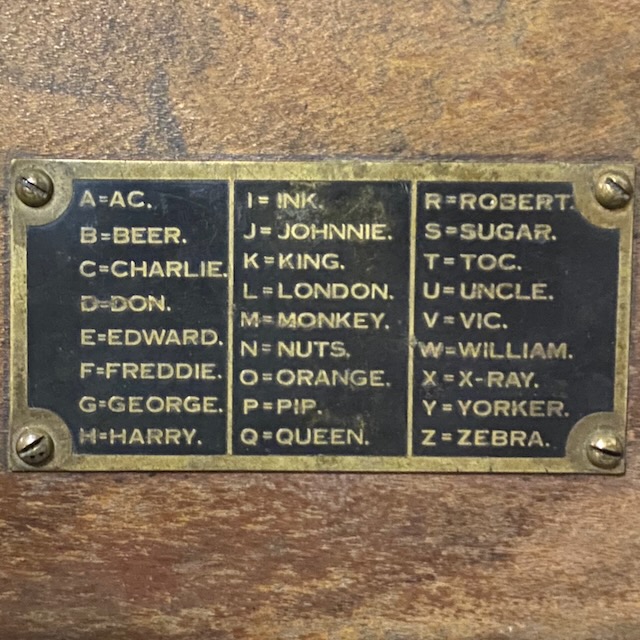
Telephone Set D.Mk.V with British 1943-1952 type spelling alphabet.

On newer west European field phones the NATO spelling table is used. Sometimes extended with local letters like e.g. Å in Norway and Denmark.
German Feldfernsprecher 54 OB/ZB. Minor deviations from NATO table: F(oxtrott) with tt and O(skar) with k.

Norwegian TP-6N-A. Minor deviation from NATO table: W(hisky) and not W(hiskey).

Norwegian FF33. The Norwegian Army used "inherited" German FF33 up to at least the 70ies.
The spelling alphabet on the box was updated with a Norwegian NATO version including a pronunciation table.
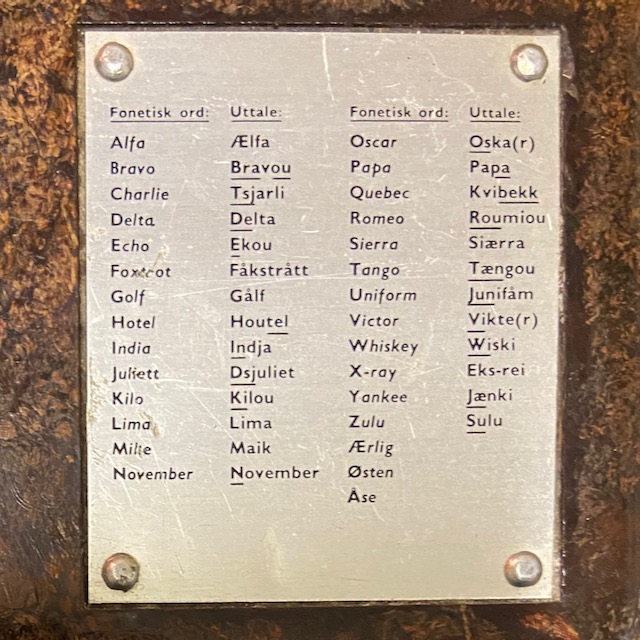
Danish M/51. Minor deviation from NATO table: X(ray) and not X(-ray).

So long, and thanks for all the letters.
Creative Commons Attribution-ShareAlike 4.0 International License